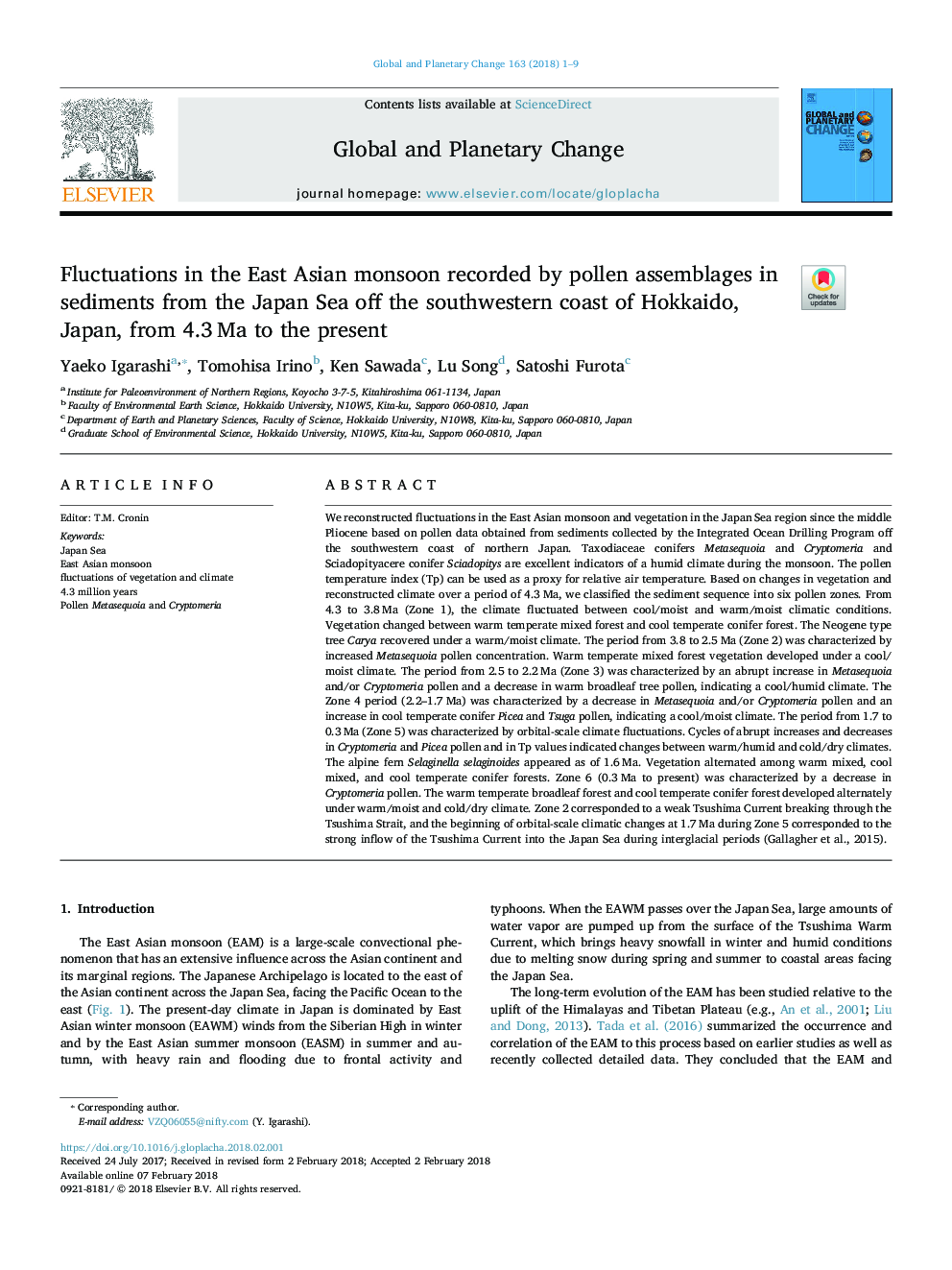| کد مقاله | کد نشریه | سال انتشار | مقاله انگلیسی | نسخه تمام متن |
|---|---|---|---|---|
| 8867528 | 1621619 | 2018 | 9 صفحه PDF | دانلود رایگان |
عنوان انگلیسی مقاله ISI
Fluctuations in the East Asian monsoon recorded by pollen assemblages in sediments from the Japan Sea off the southwestern coast of Hokkaido, Japan, from 4.3â¯Ma to the present
دانلود مقاله + سفارش ترجمه
دانلود مقاله ISI انگلیسی
رایگان برای ایرانیان
موضوعات مرتبط
مهندسی و علوم پایه
علوم زمین و سیارات
فرآیندهای سطح زمین
پیش نمایش صفحه اول مقاله

چکیده انگلیسی
We reconstructed fluctuations in the East Asian monsoon and vegetation in the Japan Sea region since the middle Pliocene based on pollen data obtained from sediments collected by the Integrated Ocean Drilling Program off the southwestern coast of northern Japan. Taxodiaceae conifers Metasequoia and Cryptomeria and Sciadopityacere conifer Sciadopitys are excellent indicators of a humid climate during the monsoon. The pollen temperature index (Tp) can be used as a proxy for relative air temperature. Based on changes in vegetation and reconstructed climate over a period of 4.3â¯Ma, we classified the sediment sequence into six pollen zones. From 4.3 to 3.8â¯Ma (Zone 1), the climate fluctuated between cool/moist and warm/moist climatic conditions. Vegetation changed between warm temperate mixed forest and cool temperate conifer forest. The Neogene type tree Carya recovered under a warm/moist climate. The period from 3.8 to 2.5â¯Ma (Zone 2) was characterized by increased Metasequoia pollen concentration. Warm temperate mixed forest vegetation developed under a cool/moist climate. The period from 2.5 to 2.2â¯Ma (Zone 3) was characterized by an abrupt increase in Metasequoia and/or Cryptomeria pollen and a decrease in warm broadleaf tree pollen, indicating a cool/humid climate. The Zone 4 period (2.2-1.7â¯Ma) was characterized by a decrease in Metasequoia and/or Cryptomeria pollen and an increase in cool temperate conifer Picea and Tsuga pollen, indicating a cool/moist climate. The period from 1.7 to 0.3â¯Ma (Zone 5) was characterized by orbital-scale climate fluctuations. Cycles of abrupt increases and decreases in Cryptomeria and Picea pollen and in Tp values indicated changes between warm/humid and cold/dry climates. The alpine fern Selaginella selaginoides appeared as of 1.6â¯Ma. Vegetation alternated among warm mixed, cool mixed, and cool temperate conifer forests. Zone 6 (0.3â¯Ma to present) was characterized by a decrease in Cryptomeria pollen. The warm temperate broadleaf forest and cool temperate conifer forest developed alternately under warm/moist and cold/dry climate. Zone 2 corresponded to a weak Tsushima Current breaking through the Tsushima Strait, and the beginning of orbital-scale climatic changes at 1.7â¯Ma during Zone 5 corresponded to the strong inflow of the Tsushima Current into the Japan Sea during interglacial periods (Gallagher et al., 2015).
ناشر
Database: Elsevier - ScienceDirect (ساینس دایرکت)
Journal: Global and Planetary Change - Volume 163, April 2018, Pages 1-9
Journal: Global and Planetary Change - Volume 163, April 2018, Pages 1-9
نویسندگان
Yaeko Igarashi, Tomohisa Irino, Ken Sawada, Lu Song, Satoshi Furota,